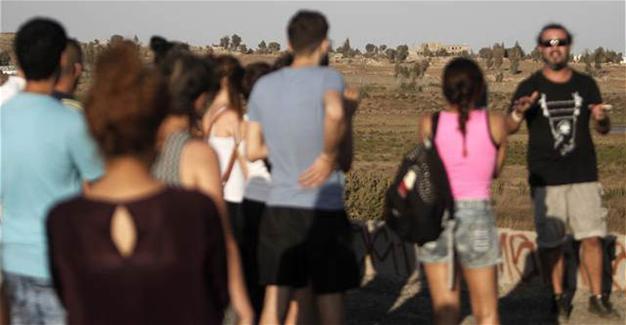High in the Golan, tourism takes on a political edge
MAJDAL SHAMS - Agence France Presse
 On top of a long-abandoned building, 50 young Arab Israelis listen attentively to Emad Madah as smoke billows into the sky in the distance behind them.
On top of a long-abandoned building, 50 young Arab Israelis listen attentively to Emad Madah as smoke billows into the sky in the distance behind them.Madah is standing in the Israeli-occupied Golan Heights near the demarcation line with Syria, explaining the fighting on the Syrian plains below.
For his guests, this is their idea of fun.
“Every time, I learn something new about nature and live out the events of history in my imagination,” says Roni Haloon, a 23-year-old student from the Arab Israeli village of Isfiya who is on his second trip with Madah.
Stunning beaches and resorts abound in the Middle East for tourists seeking rest and relaxation, but there are also other options for the more curious in the politically charged region.
Tours encompassing history or politics can also be arranged - and that’s where guides like Madah come in.
Madah gives unusual tours of the picturesque Golan Heights, which Israel took from Syria in the 1967 Six Day War, delving into history and current events surrounding the disputed territory.
Other examples of such alternative tourism include tours of the occupied West Bank led by Israelis or Palestinians providing their versions of the situation there.
Madah says his tours aim at “education and entertainment” rather than profit, and seek to help people understand “the Syrian Golan before and after the [Israeli] occupation.”
His trips also boost local businesses as his guests visit restaurants and buy goods from local farmers, including the cherries, apples, peaches and pears that grow in the region.
Madah, who works in theatre and culture, has been giving alternative tours of the Golan for seven years - which leave from the coastal city of Haifa and run a full day from 8:00 a.m. to 6:00 or 7:00 p.m. and cost about 100 shekels ($26).
As part of them, he talks about how Israel seizing the land affected the population.
On a recent tour, Madah discusses the town of Quneitra just across the demarcation line.
Israel captured and largely destroyed the town in 1967. Syria then briefly recaptured it in 1973, before Israel retook it and eventually withdrew in 1974.
Nowadays, the area around the town is held by Syrian rebels battling against Syrian President Bashar al-Assad.
A few kilometers away from the town, the Israeli army now allows visitors to tour the area’s former Syrian military headquarters, long since abandoned.
Many rooms in the three-floor building bear traces of conflict.
A sign out front is dedicated to Eli Cohen, an Israeli spy who rose to a key position in Syria in the 1960s.
He was hanged in 1965 after being discovered, but Israeli officials say the intelligence he provided was influential in winning the 1967 war.
Ruba Abu Ramheen, 20, a law student at Haifa University, says she learns something new each time she visits the Golan with Madah.
“I enjoy the nature and pass on what I learn to my friends and family,” she says.
For his guests, this is their idea of fun.
“Every time, I learn something new about nature and live out the events of history in my imagination,” says Roni Haloon, a 23-year-old student from the Arab Israeli village of Isfiya who is on his second trip with Madah.
Stunning beaches and resorts abound in the Middle East for tourists seeking rest and relaxation, but there are also other options for the more curious in the politically charged region.
Tours encompassing history or politics can also be arranged - and that’s where guides like Madah come in.
Madah gives unusual tours of the picturesque Golan Heights, which Israel took from Syria in the 1967 Six Day War, delving into history and current events surrounding the disputed territory.
Other examples of such alternative tourism include tours of the occupied West Bank led by Israelis or Palestinians providing their versions of the situation there.
Madah says his tours aim at “education and entertainment” rather than profit, and seek to help people understand “the Syrian Golan before and after the [Israeli] occupation.”
His trips also boost local businesses as his guests visit restaurants and buy goods from local farmers, including the cherries, apples, peaches and pears that grow in the region.
Madah, who works in theatre and culture, has been giving alternative tours of the Golan for seven years - which leave from the coastal city of Haifa and run a full day from 8:00 a.m. to 6:00 or 7:00 p.m. and cost about 100 shekels ($26).
As part of them, he talks about how Israel seizing the land affected the population.
On a recent tour, Madah discusses the town of Quneitra just across the demarcation line.
Israel captured and largely destroyed the town in 1967. Syria then briefly recaptured it in 1973, before Israel retook it and eventually withdrew in 1974.
Nowadays, the area around the town is held by Syrian rebels battling against Syrian President Bashar al-Assad.
A few kilometers away from the town, the Israeli army now allows visitors to tour the area’s former Syrian military headquarters, long since abandoned.
Many rooms in the three-floor building bear traces of conflict.
A sign out front is dedicated to Eli Cohen, an Israeli spy who rose to a key position in Syria in the 1960s.
He was hanged in 1965 after being discovered, but Israeli officials say the intelligence he provided was influential in winning the 1967 war.
Ruba Abu Ramheen, 20, a law student at Haifa University, says she learns something new each time she visits the Golan with Madah.
“I enjoy the nature and pass on what I learn to my friends and family,” she says.
















